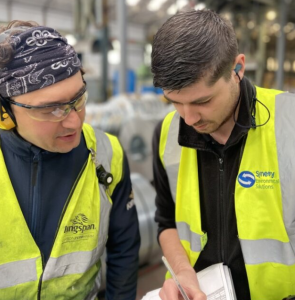A Thorough Examination and Test (TExT) is a detailed assessment of LEV systems to ensure they effectively control exposure. To check that the system is performing as originally designed, regular inspection and testing of LEV systems is a legal requirement under the COSHH Regulation 9 legislation.
The Thorough Examination and Testing of LEV is Essential due to these reasons:

1. Compliance – Regular inspection and testing of LEV systems is a legal requirement under the Control of Substances Hazardous to Health (COSHH) Regulation 9. LEV testing helps employers towards meeting their legal obligations requiring them to control the exposure to hazardous substances. As well as their duty to provide a suitable and sufficient control for hazardous substances.
2. Health of Workers – Using systems is a way of ensuring that the workplace is safe and healthy for workers who may be exposed to hazardous substances as well as helping to prevent health problems, such as respiratory disease, lung damage and cancer, that can result from inhaling harmful substances. LEV testing can help employers ensure that their operators can act protected.
3. Efficiency – Having an LEV system which is working correctly can also help towards, reducing operational costs, improving productivity, improving the overall air quality within the workplace, and enhancing the company’s environmental performance. All of which can become achieved by ensuring that the LEV systems are working effectively and adequately.
There are instances when systems do not work as intended. This is usually down to a failure in the airflow through the system.
Airflows can fall for many reasons:
- a build-up of material within the ducting or hood.
- damage to the ducting reducing airflow at the damaged point.
- an issue with the fan unit.
A reduction in airflow often leaves the system inadequate at providing effective control. These are some of the reasons why regular TExT’s are so important. Another simple way of checking for this issue is by… The use of airflow indicators at the hood and the ducting. Airflow indicators will provide you with a visual sign that the flowrate can become maintained. The protection for employees is still being provided and will show immediately if there’s a problem with the system.
Further information available below:
Local Exhaust Ventilation workplace fume and dust extraction. – This link takes you to the HSE website that explains everything you need to know about Local Exhaust Ventilation: workplace fume and dust extraction.
Frequently asked questions about LEVs. – Click the link for quick answers to frequently asked questions about LEV Systems and Testing.
HSG 258 – “Controlling Airborne Contaminants at work”. – Guidelines for designing new local exhaust ventilation (LEV) systems are included in this book. It outlines the fundamentals of selecting, creating, commissioning, and evaluating efficient LEVs.
Synergy Environmental Solutions provide sampling and consultancy services throughout the UK and Ireland. We’re happy answer any questions you may have, or provide you with a obligation free estimate for your work. Just sent us a message!


